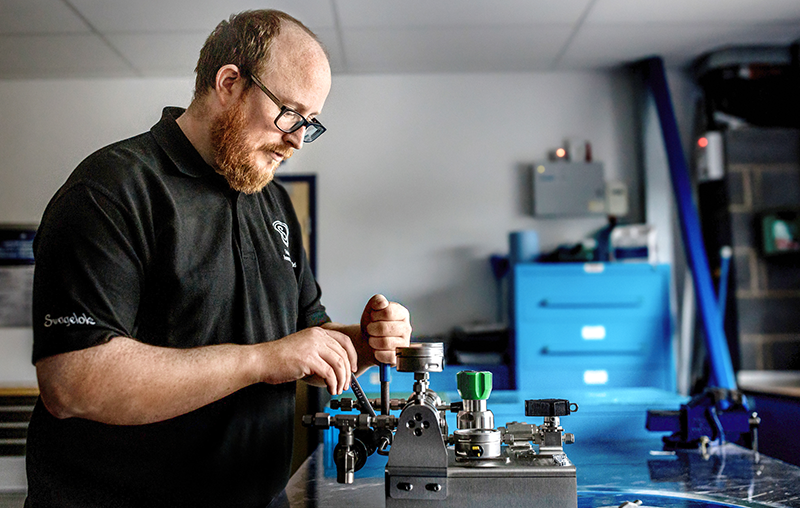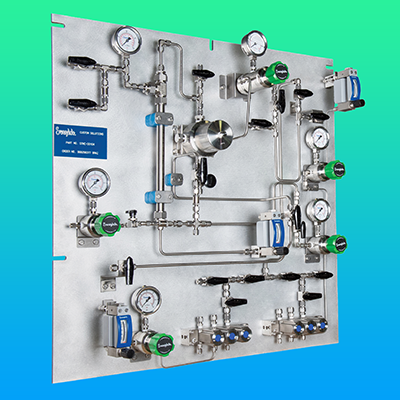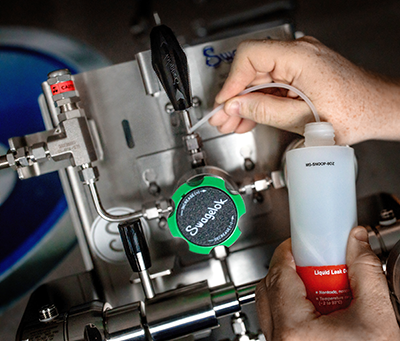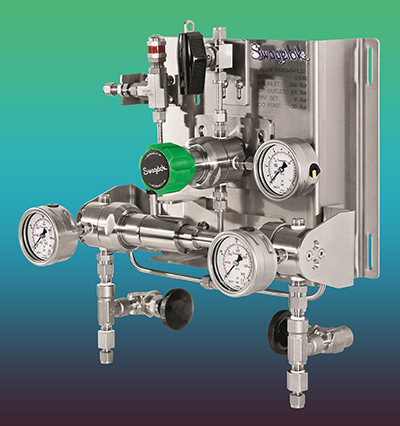
Keep your maintenance costs low with improved gas distribution
By Jeff DeWitt, Applications Engineer, Swagelok Company
Features chemical plants control panels design food and beverage gas systems maintenance Swagelok wastewater Figure 1. When designing an effective gas distribution system, make sure frequently serviced components are not obstructed by poorly placed tubing.
Figure 1. When designing an effective gas distribution system, make sure frequently serviced components are not obstructed by poorly placed tubing. Repairing gas pressure control panels can be complicated by how the pipes are laid out. Poor design could result in systems that are more prone to damage.
In addition, maintaining older gas panels can be time consuming, labor intensive, and costly (Figure 1 above).
Facilities that require gas systems to function — like food and beverage operations, wastewater treatment plants, chemical plants, and others — must be able to depend on those systems. That is why you should consider updating your gas pressure control panels to help reduce downtime and lower maintenance costs.
Why Gas Panel Design Matters
Historically, gas panel design has not always been straightforward. Systems designed without careful attention to details can leave safety relief valves and regulators accidentally obscured by enclosures.

Figure 2. Clear component labeling can cut down on the time it takes for maintenance technicians to decide what parts need to be replaced.
Alternately, extensive tubing — which requires disassembly and reassembly for maintenance to be done — also increases the possibility of unintentional damage or restricted access during repairs.
These complicating factors can confuse maintenance technicians, slowing down the repair process. Long repair times can also result in unplanned downtime or potential safety risks to employees. One way to avoid these distractions is to update your gas panels with more contemporary designs.
Modern gas panels can eliminate some of those problems by improving component visibility and labeling, particularly for components that may need frequent maintenance like regulators and pressure valves (Figure 2). In addition, many of today’s panels are designed with component replacement in mind.
Swagelok Gas Distribution Systems video: Learn how modular gas delivery system panels feature minimal threaded connections to reduce potential leak points and labeling to promote safe, simple use and maintenance.
Their modular designs mean technicians can quickly and easily replace faulty parts without taking the entire panel out of service (Figure 3). Be sure to work with a supplier that can help evaluate your system’s specific needs and make recommendations about what panels will work best for your situation.
Making Your Panels More Intuitive
It is traditional to use threaded connections between components in your gas panels. The challenge with these more complex connections is that there is a greater chance they may fail prematurely or be accidentally damaged. To reduce this possibility, tube fittings may be a better solution.
Tube fittings are more effective at stopping small, unnoticed leaks that can increase production costs over time. Moreover, small leaks can also pose significant safety issues for workers near the leaks.
Unfortunately, small leaks can go undetected for long periods. Plant operators often have other priorities to keep the production line performing well and may not have time to check the gas distribution system for leaks. As a result, small leaks do not receive the attention they need to keep them from happening. Choosing high-quality tube fittings can prevent troublesome leaks with reliable, leak-tight performance throughout the system. Facilities should partner with reputable suppliers who can inspect your system on an ongoing basis. Through these regular audits, they may be able to provide actionable insights into where improvements can be made.
Less Downtime Means Better Overall Production
Choosing high-quality components for your gas panels and distribution systems can lower maintenance costs over the life of the system by reducing leaks and potential system failures. For example, tradition suggests regulators should be replaced on a rigid five-year schedule. Since this is standard industry practice, most plant operators do not question why they must replace their regulators that often, even considering the significant disruptions that occur when a gas distribution system must be shut down for repairs.

Figure 4. If you install regulators that have been tested for millions of cycles, they may not require the typical five-year replacement schedule.
The expected five-year replacement schedule may not be necessary if higher-quality regulators are used. Typically, plant operators should seek regulators that have undergone rigorous testing — including millions of production cycles — before they ever reach your plant floor (Figure 4). If these regulators are used, it could eliminate the need to replace them at all, which lowers labour costs and keeps your facility working at peak performance.
As you evaluate your oil and gas, food and beverage, pulp and paper, chemical, or wastewater treatment facilities, improving your gas panels can provide significant savings and improved efficiencies throughout the distribution system. Modern gas distribution panels need less ongoing maintenance, allowing facilities to save money on labour-reduced system downtime. The return on investment for modern gas panels is significant, so you should prioritize updating your gas panel systems.
Jeff DeWitt is an Applications Engineer for Swagelok Company. The original version of this article appeared on the Swagelok Reference Point blog.
Print this page
